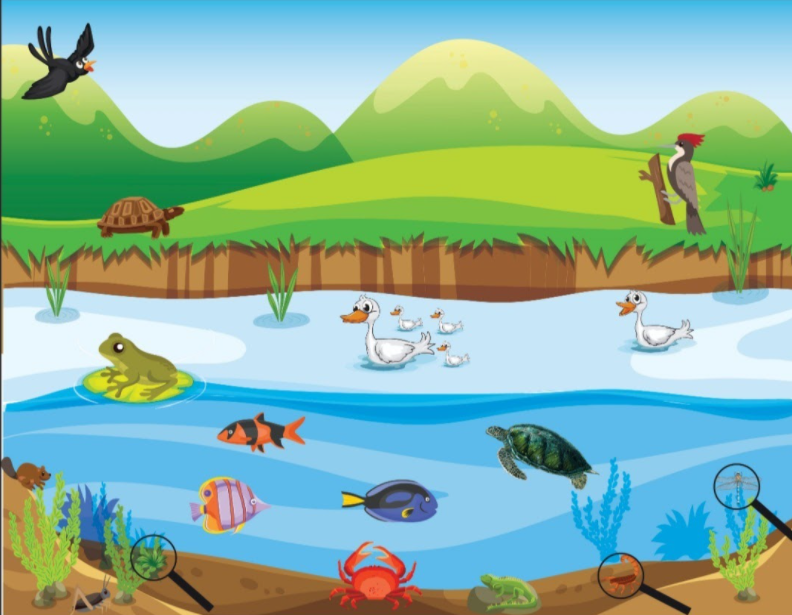
Give examples of animals found in freshwater habitat.
Answer
492k+ views
Hint: There is a large number of animals that live in freshwater. Some are amphibian which is tailless and is composing the order Anura, some are reptiles which are elongated and legless, some are molluscans that have outer hard covering and the list is very long.
Complete step by step answer:
Examples of animals found in freshwater habitat are Snails, worms, turtles, frogs, marsh birds, mollusks, alligators, beavers, otters, snakes, and many types of insects live there too. Fishes also live in freshwater habitats. Some river dolphins are also seen in freshwater habitat. Crustaceans such as shrimp or tiny water fleas are also seen in freshwater habitats. Many varieties of insects, which include biting ones such as mosquitoes to elegant dragonflies to bees, wasps, and water striders, all live close to freshwater because of standing water.

The largest freshwater habitat in the world is known as the Everglades, a 1.5 million-acre wetlands in southern Florida. The Amazon River which was situated in South America begins in the Andes Mountains and goes 4,000 miles (6,400 km) to the Atlantic Ocean; it flows through six countries, including Peru and Ecuador. Lake Baikal which was there in Siberia, a region in Russia, is the world’s biggest lake. The North Asian body of water contains about one-fifth of all the freshwater on the planet. So, it doesn't matter if you're a hungry turtle, a pollutant-sucking plant, or a thirsty human who also likes to play and enjoy in the water, freshwater habitats are vital ecosystems for our planet.
Note: Plants for example algae, cattails, water lilies, and aspen and willow trees help in keeping the water clean by using their root systems to filter pollution and excess nutrients from the water. The only way to maintain such ecosystems is to avoid polluting them with man-made products and to allow the natural flow of water into and out of the habitats.
Complete step by step answer:
Examples of animals found in freshwater habitat are Snails, worms, turtles, frogs, marsh birds, mollusks, alligators, beavers, otters, snakes, and many types of insects live there too. Fishes also live in freshwater habitats. Some river dolphins are also seen in freshwater habitat. Crustaceans such as shrimp or tiny water fleas are also seen in freshwater habitats. Many varieties of insects, which include biting ones such as mosquitoes to elegant dragonflies to bees, wasps, and water striders, all live close to freshwater because of standing water.

The largest freshwater habitat in the world is known as the Everglades, a 1.5 million-acre wetlands in southern Florida. The Amazon River which was situated in South America begins in the Andes Mountains and goes 4,000 miles (6,400 km) to the Atlantic Ocean; it flows through six countries, including Peru and Ecuador. Lake Baikal which was there in Siberia, a region in Russia, is the world’s biggest lake. The North Asian body of water contains about one-fifth of all the freshwater on the planet. So, it doesn't matter if you're a hungry turtle, a pollutant-sucking plant, or a thirsty human who also likes to play and enjoy in the water, freshwater habitats are vital ecosystems for our planet.
Note: Plants for example algae, cattails, water lilies, and aspen and willow trees help in keeping the water clean by using their root systems to filter pollution and excess nutrients from the water. The only way to maintain such ecosystems is to avoid polluting them with man-made products and to allow the natural flow of water into and out of the habitats.
Recently Updated Pages
Master Class 11 Economics: Engaging Questions & Answers for Success

Master Class 11 Business Studies: Engaging Questions & Answers for Success

Master Class 11 Accountancy: Engaging Questions & Answers for Success

Master Class 11 English: Engaging Questions & Answers for Success

Master Class 11 Computer Science: Engaging Questions & Answers for Success

Master Class 11 Maths: Engaging Questions & Answers for Success

Trending doubts
Which one is a true fish A Jellyfish B Starfish C Dogfish class 11 biology CBSE

State and prove Bernoullis theorem class 11 physics CBSE

1 ton equals to A 100 kg B 1000 kg C 10 kg D 10000 class 11 physics CBSE

In which part of the body the blood is purified oxygenation class 11 biology CBSE

One Metric ton is equal to kg A 10000 B 1000 C 100 class 11 physics CBSE

Difference Between Prokaryotic Cells and Eukaryotic Cells




